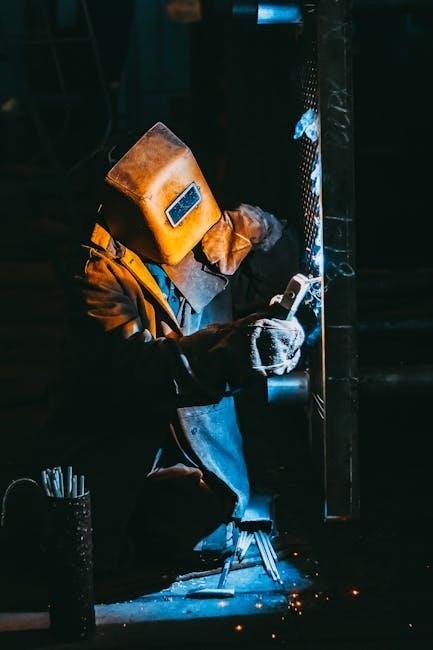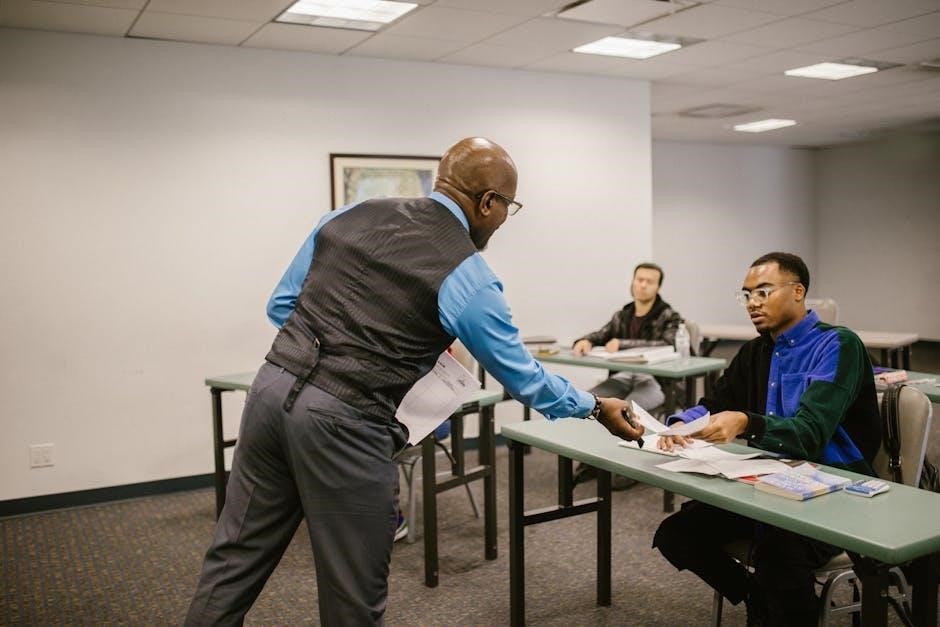j-b weld instructions
J-B Weld Instructions: A Comprehensive Guide
Apply the J-B Weld Original mixture to the broken area and clamp or hold the pieces together until the glue has set (J-B Weld Original sets in 20-25mins)․ Once set, drill & tap if needed!
What is J-B Weld?
J-B Weld is a renowned epoxy adhesive system known for its incredible strength and versatility․ Often referred to as “cold weld,” it provides a robust alternative to traditional welding methods, especially when dealing with materials that are difficult or impossible to weld using conventional techniques․ J-B Weld is a two-part epoxy system, consisting of a resin and a hardener, which, when mixed in equal parts, create a powerful bond capable of repairing a wide range of materials, including metal, wood, plastic, ceramic, and more․ Its ability to withstand high temperatures and resist water, chemicals, and solvents makes it suitable for both indoor and outdoor applications․ From automotive repairs and plumbing fixes to household projects and crafting endeavors, J-B Weld offers a reliable solution for bonding, filling, and sealing various surfaces․ Its ease of use, combined with its exceptional bonding strength, has made it a staple in workshops, garages, and homes worldwide․ Whether you’re mending a broken pipe, restoring a damaged engine component, or simply joining two pieces of material together, J-B Weld provides a durable and long-lasting repair that can withstand the test of time․ This comprehensive guide will provide detailed instructions on how to effectively use J-B Weld for a variety of applications, ensuring optimal results and a strong, reliable bond every time․

Preparation Before Application
Before diving into the application of J-B Weld, proper preparation is key to achieving a strong and lasting bond․ This stage involves thoroughly cleaning the surfaces to be joined and accurately mixing the two-part epoxy for optimal performance․
Cleaning the Surface
Prior to applying J-B Weld, meticulous surface preparation is paramount for ensuring a robust and durable bond․ The presence of any contaminants, such as dirt, grease, oil, rust, or loose paint, can significantly impede the epoxy’s ability to properly adhere to the substrate․ Therefore, a thorough cleaning process is essential to remove these impurities and create an optimal bonding surface․
Begin by physically removing any loose debris or flaking material using a wire brush, sandpaper, or a scraper․ For stubborn rust or corrosion, consider employing a rust remover or a specialized abrasive tool․ Once the loose particles have been eliminated, proceed to degrease the surface with a suitable solvent, such as acetone, isopropyl alcohol, or a commercial degreaser․ Apply the solvent generously to a clean cloth and wipe the surface thoroughly, ensuring that all traces of grease and oil are removed․ Multiple applications may be necessary for heavily contaminated surfaces․
After degreasing, it is advisable to further enhance the surface for optimal adhesion by lightly abrading it with sandpaper or a sanding block; This process creates microscopic ridges and grooves that increase the surface area available for bonding, providing a stronger mechanical key for the J-B Weld to grip․ Use a medium-grit sandpaper (e․g․, 120-grit) and gently sand the area to be bonded, taking care not to remove excessive material․ Once sanding is complete, remove any sanding dust with a clean cloth or a vacuum cleaner․
Finally, perform a final wipe-down with a clean cloth dampened with isopropyl alcohol to remove any remaining residue or contaminants․ Ensure that the surface is completely dry before proceeding to the next step of mixing and applying the J-B Weld․ By diligently following these surface preparation steps, you can significantly improve the bond strength and longevity of your J-B Weld repair, ensuring a successful and reliable outcome․
Mixing J-B Weld
Achieving the correct mixture ratio of J-B Weld is crucial for ensuring its proper curing and achieving optimal bond strength․ J-B Weld typically comes in two separate tubes or containers: one containing the resin and the other containing the hardener․ These two components must be mixed together in precise proportions to initiate the chemical reaction that leads to the hardening and bonding process․ Deviating from the recommended ratio can result in a weakened bond or a failure to cure properly․
To begin the mixing process, gather the necessary materials, including the J-B Weld resin and hardener, a disposable mixing surface (such as a piece of cardboard or a plastic mixing tray), a mixing stick or spatula, and a measuring device (such as a syringe or a set of measuring spoons)․ Squeeze out equal parts of the resin and hardener onto the mixing surface․ It is essential to use equal volumes of each component, as this ensures the correct chemical balance for proper curing․ If using a syringe, draw equal amounts of resin and hardener into separate syringes and then dispense them onto the mixing surface․ If using measuring spoons, carefully measure out equal spoonfuls of each component․
Once the resin and hardener are dispensed onto the mixing surface, use the mixing stick or spatula to thoroughly combine the two components․ Mix the resin and hardener together vigorously, ensuring that they are completely blended and that there are no streaks or swirls of either component remaining․ The mixing process should take approximately 1-2 minutes to ensure a homogenous mixture․ Scrape the sides and bottom of the mixing surface to ensure that all of the resin and hardener are incorporated into the mixture․
The resulting mixture should have a uniform color and consistency․ If the mixture appears streaky or uneven, continue mixing until it becomes homogenous․ Once the J-B Weld is thoroughly mixed, it is ready to be applied to the prepared surface․ It is important to note that J-B Weld has a limited working time once mixed, so it is essential to apply it promptly after mixing to ensure proper adhesion and bonding․ Discard any unused mixed J-B Weld after the application process is complete․

Application Process
The application process involves carefully applying the mixed J-B Weld to the prepared surfaces, ensuring proper contact and coverage․ Depending on the specific J-B Weld product, you may apply with a tool in an even coat, weld bead, or extruded shape․
Applying the Mixture
Once the J-B Weld components are thoroughly mixed, the application process is crucial for achieving a strong and durable bond․ The method of application can vary depending on the specific J-B Weld product being used and the nature of the repair․ For instance, J-B Weld Original can be applied to a broken area, while products like SteelStik might require a different approach․
Before applying, ensure the surface is clean and dry, as contaminants can weaken the bond․ Use an appropriate tool, such as a putty knife, applicator stick, or even a syringe for precision, to apply the mixture evenly․ The goal is to create a consistent layer that fills the gaps and adheres to both surfaces being joined․
For larger gaps or areas requiring significant reinforcement, consider applying multiple layers of J-B Weld․ Allow each layer to partially cure before applying the next to prevent sagging or running․ This technique is particularly useful when repairing vertical surfaces or filling deep voids․
When applying J-B Weld to threads or fasteners, ensure the threads are thoroughly coated to provide a secure and leak-proof seal․ Avoid over-tightening the fastener, as this can damage the J-B Weld and compromise the repair․
In some cases, it may be necessary to mold or shape the J-B Weld mixture during the application process․ This can be achieved using tools such as sculpting tools or even your fingers (wearing gloves, of course)․ The goal is to create a smooth, even surface that blends seamlessly with the surrounding material․
Remember to work quickly and efficiently, as J-B Weld has a limited working time․ Once the mixture begins to harden, it becomes difficult to manipulate and may not bond properly․ If you need to apply J-B Weld to a large area, consider mixing smaller batches to ensure you have enough time to work with each batch․
After applying the J-B Weld, remove any excess material and clean up any spills or drips immediately․ This will prevent the hardened J-B Weld from becoming a permanent fixture on surrounding surfaces․ Use a solvent such as acetone or mineral spirits to clean up any residue․
Finally, inspect the applied J-B Weld to ensure it is properly positioned and that there are no gaps or voids․ If necessary, make any adjustments or corrections before the J-B Weld begins to cure․ Once you are satisfied with the application, proceed to the clamping and holding stage to ensure a strong and durable bond․
Clamping and Holding
Following the application of J-B Weld, securing the repaired components is paramount to ensure a robust and lasting bond․ This is where clamping and holding techniques become essential․ The primary objective is to maintain consistent pressure and alignment between the joined surfaces throughout the curing process․ This prevents movement or shifting that could compromise the integrity of the repair․
The choice of clamping method depends largely on the shape, size, and material of the objects being joined․ For simple repairs involving flat surfaces, standard clamps such as C-clamps, spring clamps, or vise grips can be used․ Ensure that the clamps are applied evenly and that the pressure is distributed uniformly across the repair area․ Avoid over-tightening the clamps, as this can squeeze out the J-B Weld and weaken the bond․
For more complex shapes or delicate materials, consider using specialized clamps designed for specific applications․ For instance, band clamps are ideal for securing cylindrical objects, while corner clamps are useful for joining corners at precise angles․ Alternatively, you can create custom clamping jigs using wood, metal, or other materials to provide support and alignment during the curing process․
In situations where clamping is not feasible, alternative holding methods can be employed․ One common technique is to use weights to apply pressure to the repaired area․ Sandbags, bricks, or other heavy objects can be strategically placed to maintain contact between the joined surfaces․
Another option is to use adhesive tape, such as masking tape, duct tape, or electrical tape, to hold the components together․ This is particularly useful for lightweight materials or repairs where minimal pressure is required․ Be sure to use a tape that is compatible with J-B Weld and that will not leave any residue on the repaired surface․
For vertical surfaces or overhead repairs, consider using props or supports to hold the components in place․ Wooden blocks, shims, or even temporary bracing can be used to prevent the repaired area from sagging or shifting during the curing process․
Regardless of the clamping or holding method used, it is crucial to monitor the repair closely during the initial stages of curing․ Check for any signs of movement, slippage, or distortion, and make any necessary adjustments to ensure that the components remain properly aligned․
Once the J-B Weld has fully cured, carefully remove the clamps or holding devices․ Inspect the repaired area to ensure that the bond is strong and that there are no gaps or voids․ If necessary, perform any final finishing or touch-up work to complete the repair․

Curing Time
Sets in 4-6 hours․ Cures in 15-24 hours․ Allow 4-6 hours before handling and 15 hours (minimum) before putting object back in use․ The J-B Weld Original mixture to the broken area and clamp until the glue has set
Setting and Curing Durations
Understanding the setting and curing durations of J-B Weld is crucial for achieving optimal results in your repairs․ These times dictate when you can handle the repaired item and when it’s ready for full use․ Different J-B Weld products have varying setting and curing times, so it’s essential to consult the product packaging or instructions before beginning your project․ For example, J-B Weld Original typically sets in approximately 4-6 hours, meaning the mixture will begin to harden and hold its shape within this timeframe․ However, the curing process, which involves the epoxy fully bonding and reaching its maximum strength, takes longer, usually around 15-24 hours․
During the setting phase, it’s vital to keep the repaired pieces clamped or held together to ensure proper alignment and adhesion․ Avoid disturbing the joint during this period, as any movement can weaken the bond․ Once the J-B Weld has set, you can carefully remove the clamps․ However, remember that the repair is not yet fully complete․ The curing phase is when the epoxy undergoes a chemical reaction that strengthens the bond to its maximum potential․
It’s generally recommended to allow a minimum of 15 hours for curing before putting the repaired object back into use․ For heavy-duty applications or repairs subjected to significant stress, extending the curing time to 24 hours or longer is advisable․ Factors such as temperature and humidity can also affect curing times․ Warmer temperatures tend to accelerate the curing process, while colder temperatures may slow it down․ Similarly, high humidity can sometimes prolong curing times․
Always refer to the specific J-B Weld product instructions for the most accurate setting and curing time recommendations․ Following these guidelines will ensure a strong and durable repair that lasts․

Post-Application
After the curing process is complete, you might need to perform additional steps, such as drilling or tapping․ If you really have to use JB Weld, drill the hole bigger, make the walls rough enough to grip then fill with the mixture․
Drilling and Tapping
Once J-B Weld has fully cured, it becomes a hard, durable substance that can be machined, drilled, tapped, sanded, and filed․ This opens up possibilities for further refining the repair or modification․ Drilling and tapping are common post-application procedures that allow you to create threaded holes for screws or bolts, enabling you to attach other components or reinforce the repair; However, it’s essential to follow proper techniques to ensure successful drilling and tapping without damaging the J-B Weld or the surrounding material․
Drilling:
- Select the Right Drill Bit: Use a sharp, high-speed steel drill bit designed for metal․ The size of the drill bit will depend on the desired hole size for your screw or bolt․
- Center Punch: Before drilling, use a center punch to create a small indentation at the precise location where you want to drill the hole․ This will help prevent the drill bit from wandering․
- Start Drilling Slowly: Begin drilling at a slow speed with consistent pressure․ Avoid applying excessive force, which can cause the J-B Weld to crack or chip․
- Use Cutting Oil: Apply a few drops of cutting oil to the drill bit and the J-B Weld surface to lubricate the process and reduce heat buildup․
- Drill in Increments: If you need to drill a deep hole, drill in small increments, removing the drill bit frequently to clear away any debris․
- Deburr the Hole: After drilling, use a deburring tool or a larger drill bit held at an angle to remove any sharp edges or burrs around the hole․
Tapping:
- Select the Right Tap: Choose a tap that matches the thread size of your screw or bolt․ You’ll typically need a set of three taps: a taper tap, a plug tap, and a bottoming tap․
- Start with the Taper Tap: Begin by using the taper tap, which has a gradual taper that helps start the threads․ Apply cutting oil to the tap and turn it clockwise, applying gentle pressure․
- Advance to the Plug Tap: After the taper tap has created some threads, switch to the plug tap, which has a less pronounced taper․ Continue tapping, applying cutting oil and turning the tap clockwise․
- Finish with the Bottoming Tap: Finally, use the bottoming tap, which has no taper, to create threads all the way to the bottom of the hole․
- Back Out and Clean: After each pass with a tap, back it out a few turns to break any chips and clear the threads․ Clean the tap and the hole frequently to remove debris․
- Test the Fit: Once you’ve tapped the hole, test the fit of your screw or bolt to ensure it threads in smoothly and securely․
Important Considerations:
- Avoid Over-Tightening: When installing screws or bolts into tapped holes in J-B Weld, avoid over-tightening, which can strip the threads or crack the material․
- Use Thread Lockers: For applications where vibration or loosening is a concern, consider using a thread locker compound to secure the screws or bolts․
- Reinforce with Inserts: For high-stress applications, you can reinforce the tapped holes with threaded inserts, which provide stronger and more durable threads․
By following these guidelines, you can successfully drill and tap J-B Weld, allowing you to create secure and functional repairs or modifications․
